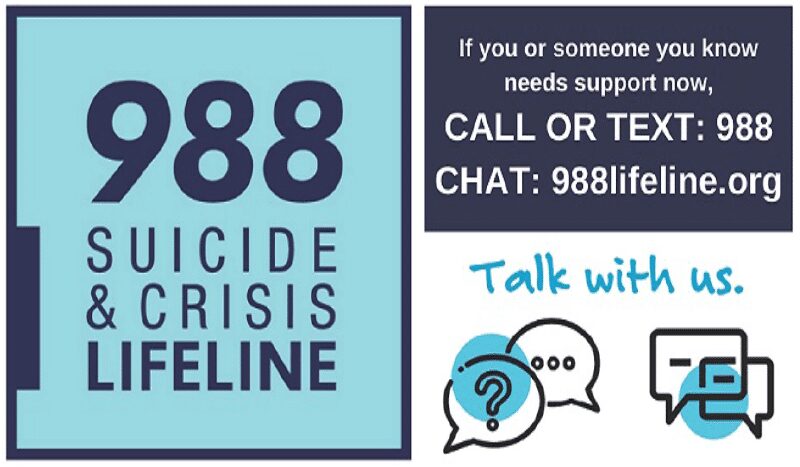Since the early 1990’s suicide rates in the US have steadily increased. This increase has created a suicide crisis. Rates in 2022 were 3% higher than in 2021, and 2023 data looks to add to that increase. This is a crisis that receives little attention. As a mental health provider, I want to inform my networks about the issues around suicide in the hopes that we, as a larger community, can prevent needless deaths. Below is a graph of the suicide rate per 100,000 population from 2001 – 2021.

This highest year was 2018 with a rate of 14.79 per 100,000 population. There was a small decline in 2019 and 2020 during the pandemic. But rates rose again in 2022, and 2023 seem to be on par with 2021, quite possibly trending higher. Currently, unofficial data for 2022 shows a 2.79% increase over 2021, making it the highest year yet (possibly 14.93 per 1000,000 population). 2023 data is incomplete and hard to predict since some months have not been reported.
A first question many ask, is what might be contributing to increase rates of suicide. A Colorado University study has analyzed that data and found two recent developments that are likely contributing to the suicide increase.
- Increased access to powerful opioids has contributed to a rise of suicide among women.
- The decrease in the federal safety net has led to increased financial stress for all adults.
Easy access to a particular lethal method can make suicide much easier to accomplish. Malcolm Gladwell in his book Talking to Strangers illustrated how suicide rates plummetted in the United Kingdom in the 1960s as the country switched from “town gas” to natural gas. Town Gas had a much higher concentration of carbon monoxide and lethal limits were reached much more quickly than natural gas. This information has bearing on our conversations about guns, and now the opioid crisis. Easy access to lethal methods is a danger. It is important to consider the methods available to those suffering from suicidal ideation. As a therapist, I often ask about weapons in the home, and now medications in the home. And as a larger community, we need to be talking about gun restrictions because these regulations will save lives by limiting access.
We know that men are more often more likely to kill themselves with an attempt because they often choose more violent methods such as guns or hanging. Suicide attempts by women are on the rise, and especially by younger generations. Though women choose less violent methods, the very powerful effects of medication can have deadly results, thus raising their overall rate of actual suicides. Opioids were involved in more than 80,000 overdose deaths in 2021, which was 10 times the number of opioid overdose deaths in 1999. Our communal value of human life should lead us to support all efforts to eradicate the flow of deadly opioids into our communities.
Stress, and specifically economic stress, can be a major contributor to suicide. Currently, the high rates of inflation are impacting many lower-income families in a disproportionately negative way. When we look at state-by-state rates of suicide, the highest rates seem to occur in rural farming communities. The economic uncertainties of an agricultural world, access to means (usually guns), and social isolation are all contributors to higher rates. Not only can we be only the look out for our “neighbor” and their economic stresses, but we can advocate or vote for policies that lead to safety net supports being implemented to reduce economic losses for the most vulnerable in our communities.
There is HOPE, because we can all play a part in the prevention of suicide. Relationships are the key to suicide prevention. Let me give you a few ideas for what you can do.
- Show you care about others. Check in on your neighbors if you have not seen them for some time. Inquire about the grief’s and even economic challenges you know family and friends might be experiencing. Ask them how they are doing and be a bit persistent if they just blow off the question with a dismissive, “Fine.” Take care of those closest to you first.
- Don’t be afraid to ask the question, “Have your thought about dying, killing yourself?”, “Are you wishing you were not here or were not alive right now?”
You might be a bit afraid to ask, but research is really clear that our best prevention is to ask this questions. If your gut tells you that you need to ask the question, then don’t be afraid. It often opens a dialogue and can help facilitate a plan to save a life. - Develop a safety plan. Don’t leave anyone that is actively suicidal alone. Suicidal ideation does not necessarily mean there needs to be a rush to a psychiatric hospital or the ER. Call the National Suicide Hotline, which is available 24:7 with professionals who can help with a plan. You can contact the National Suicide Hotline by calling or texting 988. It is that simple. Maybe they have a therapist they can contact who can help them develop a safety plan. Telehealth has made mental health far more accessible.
- The QPR Institute has developed a well-researched intervention method for helping prevent suicide. It is a three-step model: Question—Persuade—Refer. Just like CPR can save a life, this model can prevent suicide. They offer numerous training opportunities to learn the model, including online and in-person training. If you are a decision-maker for your company or church, why don’t you pursue bringing a trainer into your organization to teach these prevention tools to everyone?

Leave a Reply